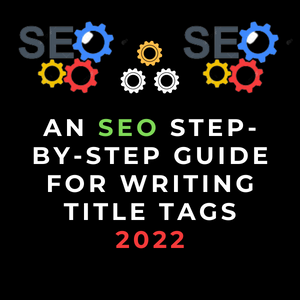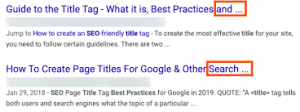
Do you want to boost the search engine optimization of your website? The title tag optimization is one of the most usually disregarded factors. You have the potential to see a huge improvement in your website’s organic search exposure if you can understand all of the tiny ways to optimize them.
Whether you want to boost your website’s SEO or make a content marketing strategy more effective, optimizing title tags is a crucial step. This article will discuss optimal writing methods and how titles might affect search results ranks and CTR (click-through rate).
Table of Contents
Title Tags: An Overview
Page titles are another name for title tags. You may also hear them referred to as HTML titles or Website titles.
The title tag is a clickable title for a webpage that shows alongside the SERP result (search engine page results page). Use the <title> tag in the HTML around your text to create a page title.
<head> <br/> <title>This is My Site Title</title><br/></head><br/><br/><br/>
When establishing new pages on your website, most content management systems, such as WordPress, feature forms that automatically set <title> tags around the page names.
Because Google can only display 60-70 characters of a page title in the search results, you should aim for SEO titles that are around 60 characters long. Clear title tags will help your website be easier to read and understand.
Importance of Title Tags
The theme of the webpage is communicated through title tags to both users and search engines. They also provide an assessment of how relevant a page is to a searcher’s query to search engines. As a result, title tags, also known as page titles, should be as accurate and relevant to the content of the page as possible.
Where Can I Find Title Tags or Page Titles?
Your page names will show in a few other locations besides your website, which you should be aware of. If you’re attempting to get people to notice your website through search, you’ll need a title that works everywhere.
1. In Browser Tab
The text that appears on the tab of your browser is the title tag. As a result, your page title should be able to quickly and easily remind readers about the content of your page.
2. On Search Engine Results Page (SERP)
After being indexed by a search engine, the page title also appears on the results page. The title tag on Google is the blue text link that can be clicked to go to the page. As a result, you want your title tag to function as a headline, encouraging searchers to click on your result.
3. On other people’s websites (External Websites)
External websites and social media accounts frequently use the Title Tag as the anchor text when linking to a page. This is another reason why your page title should clearly explain the page’s content.
Tips for Writing Title Tags: SEO and Tactics
Because the title is frequently the first impression of your link and where the visitor would position their cursor when clicking through, titles have a direct impact on a page’s CTR.
As a result, writing title tags is an important SEO step because they must meet all search engine requirements while also being appealing to users. Your title should convey what’s on the page, include the target keyword, and elicit an emotional or mental response from the reader.
The same principles that apply to writing a great headline will also apply to your page titles. According to one of the arguments in the preceding article:
“A successful headline must have three elements: numbers, simplicity, and trigger words.”
A good title grabs your attention and entices you to click on the link or read the rest of the article.
1. Words to Use for a Higher CTR
Using phrases like HOW, WHAT, WHY, and WHERE on the page gives readers a sense of what to expect in terms of answers to their questions.
Adjectives like BEST, REVIEW, ULTIMATE, and others are popular trigger words that draw a reader’s attention.
2. Names of Businesses and Brands
You might be wondering when it’s appropriate to put your company’s or brand’s name in a page’s title. It all relies on how it’s put to use. If numerous pages on your site are returned for the same query, it might affect readability, CTR, and look repetitive if you have recurring titles with just your company name.
It makes sense to include a brand or company name in the title tag for home pages:

You want the title tag on service or product pages to reflect what customers might be looking for. Many businesses choose to highlight the product or service they’re trying to offer before adding their company name at the end:


You can see the use of trigger words like “Free” as well as the name of the firm that sells the goods in the sample above. Because the brand name corresponds to what people are looking for, it was a good idea to incorporate it in the title tag. You should concentrate on getting visitors to click; only you can decide whether or not your company name is required.
3. Truncation of Title Tags
The width of title tags is limited to 600 pixels by Google (but this can sometimes vary depending on the device being used). Google may truncate the title tag if it exceeds this limit.
The following is an example of title tag truncation:

One title tag seems cleaner than the other, as you can see in the images above. There are numerous tools available that will check your titles, meta descriptions, and URLs to ensure that they are the correct character and pixel length.
Page Title Mistakes in SEO
When SEMrush did a study on common on-page SEO issues, we discovered that title tags were the third most common issue. Duplicate title tags, titles that were too long, and titles that were too short were among the concerns.
Titles that are too long will not appear in full in search results, while titles that are too short will not provide enough information for search engine algorithms to grasp what the page is about.
If you have duplicate titles, search engines may be unsure which page to rank, resulting in poorer ranks for each of your pages.
To avoid any issues with your page titles, make sure your title tags are the appropriate length and unique to each page.
Quick Steps
- Keep titles to a maximum of 55-60 characters.
- In titles, use keywords that are relevant to your business.
- Describe the content of your page as accurately as possible.
- Help folks comprehend what they’ll find on the page by using words like HOW, WHY, WHAT, and WHERE.
- Use phrases like BEST, REVIEW, and ULTIMATE to persuade people to click.
- Don’t use the same title twice!
- Make good use of your company’s or brand’s name.
- Maintain a straightforward approach.
Conclusion
While enhancing your site’s SEO may appear to be a daunting task at times, there are numerous small steps you can do to increase your visibility. Click-through rates and SEO can all be improved by using title tags, URLs, and meta descriptions.

